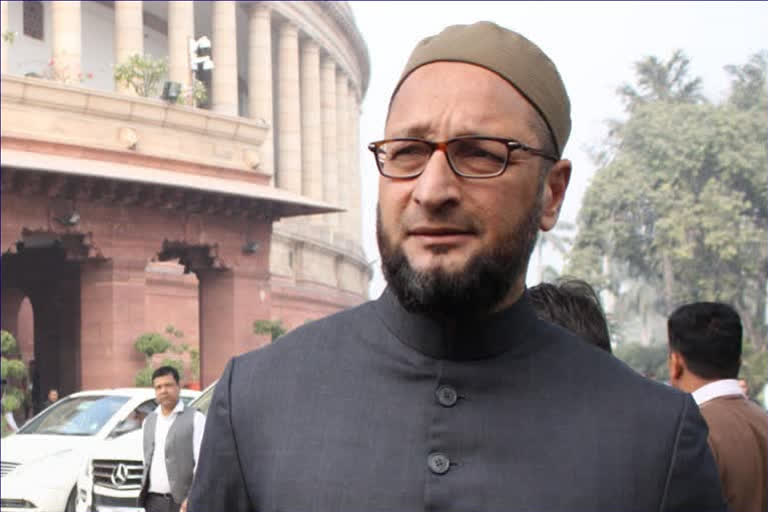Hyderabad (Telangana): The All India Majlis-e-Ittehad-ul-Muslimeen (AIMIM) has already started gearing up preparations for contesting at least 10 seats in the West Bengal Assembly elections, and with that, the issue of polarization of votes and categorising the Muslim minority as a vote bank in the state have yet again come to the fore. To stoke the fire a bit more, another Muslim clergy Abbas Siddiqui has floated his Indian Secular Front. Together with AIMIM he can make life uneasy for many, mostly for the ruling Trinamool Congress.
Assessing the minorities as a vote bank has been a longstanding tradition of Bengal's politics and doesn't just remain restricted during the poll season. It keeps coming back with posters and cutouts of Mamata Banerjee posing in a particular way and praying. These posters and banners are released precisely ahead of annual festivities and rituals of a particular religious community. The Trinamool Congress government's decision to sanction a monthly stipend for Imams and Muezzins has been the latest from the kitty of Mamata Banerjee.
The Left Front, which had ruled Bengal for 34-years, was also not far in this race of appeasement politics. In fact, it had its own version of tactics to garner the most out of the Muslim minority during every poll season, be it doles or institutionalising the Madrassa Board or a university solely dedicated to minority Muslim studies. The CPIM had announced its intention to create a 10% reservation for Muslims in government jobs in the fag end of its stint, but could never implement it. They were voted out. With an expectation that Muslim voters will play a key role in elections, no party could ignore them.
But, BJP had dealt a different card in the 2019 general elections.
The polarisation of voters had never been so pronounced in the Bengal elections as it happened in the last Lok Sabha polls. During the 2001 and 2006 polls, BJP was a mere fence-sitter. Though the party was playing the role of a junior ally to the Trinamool Congress in 1998, 1999 and the 2004 general elections, Mamata preferred the Congress when it came to the state elections. Even in the 2011 Assembly elections when Mamata finally managed to trounce the Left Front, she had allied with the Congress and not the BJP. The saffron party had secured a mere 4.1% vote share in that election.
In 2016, Mamata went alone and again emerged victorious against the Left Front-Congress combine as well as the BJP, which was now the ruling party at the Centre with Narendra Modi as the Prime Minister. Interestingly, BJP now had about 10% vote share. In the 2019 general elections, BJP emerged as the leading opposition in West Bengal with a phenomenal 40% vote share.
Was it only popular vote? Was it due to the fact that the Left Front's vote share collapsed from 27% to 7.5% or the slide of the Congress' vote share by around 7% and the Trinamool's by around 2%?
BJP was successful in focusing on the Hindu as well as the Hindu-immigrant voters and romp home the numbers. Once this polarisation was achieved, the next thing which happened in favour of BJP was the en masse shift of Left Front voters to the saffron party between 2016 and 2019. A rough estimate puts the figure at a staggering one crore Left voters making their way to the BJP.
The result, BJP ended with its best-ever figure of 18 seats in the 2019 Lok Sabha polls. Parallel to polarisation was the busting of the myth that in West Bengal, the Muslim minorities never vote for the BJP. Surely there is enough space of debate that, did BJP bag popular Muslim vote in 2019? Or was it hidden under the wraps of Left Front and Congress voters? Whichever way, numbers do reflect much.
South Malda Lok Sabha seat has 64% Muslim voters. The 2019 vote results show the Congress candidate getting 4,44,270 votes (34.73%) and Trinamool Congress candidate getting 3,51,353 votes (27.47%). BJP's figures, 4,36,048 votes (34.09%).
In Jangipur Lok Sabha constituency, the Muslim voters' concentration is around 82%. Here the BJP candidate had secured 24.3% vote share. Trinamool Congress candidate bagged 43.15% and the Congress candidate had 19.61% in his kitty.
Numbers of these two Lok Sabha constituencies are enough to speak for others. In fact, going by the 2011 Census and later estimates, the 30%-plus Muslim population in West Bengal is capable of influencing the outcome of around 102 Assembly constituencies. Roughly translated, it is almost 35% of the entire strength of the Assembly.
After tasting the goods at the 2019 polls, it is unlikely that BJP will restrict itself to Hindu votes. The chunk of Muslim votes coming its way will only be a welcome break for the party in its fight against a 'secular' Mamata Banerjee.
With AIMIM ready to vie for its pie and Abbas Siddiqui putting behind all Pirzadas of the extremely influential Furfura Sharief in terms of popularity, the Muslim population of West Bengal is now ready to shed its 'vote bank' tag. Are political parties ready to accept the inevitable and treat them as voters and not a vote bank? The poll arithmetic of 2021 Bengal is only getting interesting by the day.



